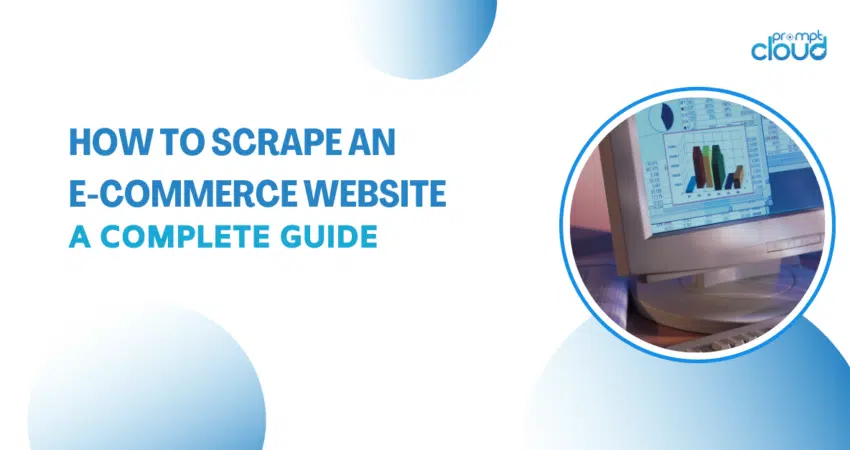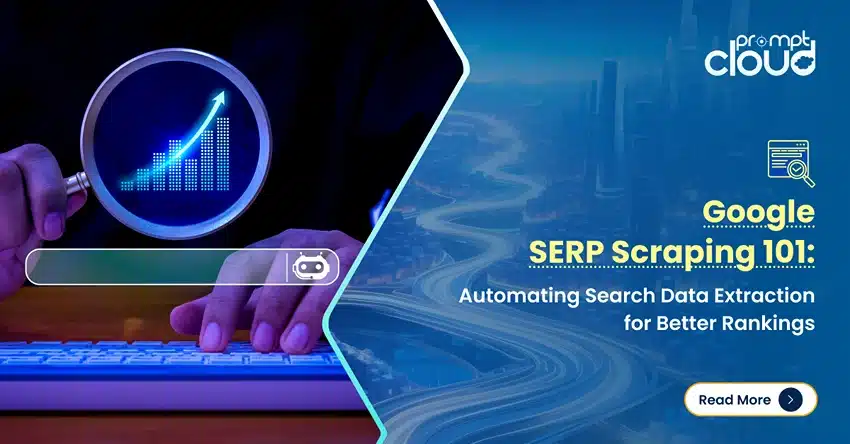
Imagine you’re an aspiring entrepreneur, filled with enthusiasm to launch your online store, specializing in cutting-edge gadgets. To make strategic choices and establish competitive pricing, it’s crucial to stay informed about your competitors’ activities. You need insights into product prices, trends, and availability.
But how do you gather all this data without spending countless hours manually clicking through websites? Web Scraping!
In this guide, we’ll delve into how to scrape an e-commerce website ethically and effectively.
What does scraping an e-commerce website mean?
Web scraping, or web data extraction, in general, refers to the automated process of extracting data from websites. It involves fetching, parsing, and organizing website content for subsequent analysis.
Given that e-commerce websites house an extensive wealth of valuable information, extracting data from these platforms can provide substantial benefits to businesses aiming to gain a competitive edge.
Understanding E-commerce Website Structure
Before diving into scraping an e-commerce website, it is crucial to understand its structure. E-commerce websites typically consist of various pages, including product listings, product details, category pages, and search results.
Every page encompasses distinct components and information available for extraction, such as product names, pricing details, descriptions, user reviews, and additional content. Having a grasp of a website’s structure equips you with the skills needed to efficiently explore the website and retrieve the desired information.
Scraping E-commerce Data
Now, let’s dive into the details of how to scrape e-commerce websites. This process can be divided into the following steps:
Step 1: Sending HTTP Requests
The initial step involves dispatching HTTP requests to the e-commerce website. It’s essential to exercise caution during this stage to prevent overwhelming the server with excessive requests, which could lead to potential banning. Employing a proxy or regularly changing IP addresses can help you evade detection and maintain a smoother scraping process.
Top of Form
Step 2: Parsing and Extracting Data
After obtaining the HTML content, the next step involves parsing it to extract the pertinent information. This is where tools like Beautiful Soup and Scrapy truly shine. They empower you to precisely specify the elements you intend to extract, such as product names, prices, descriptions, and images.
Step 3: Handling Dynamic Content
Numerous e-commerce websites utilize JavaScript to dynamically load content. When extracting data from these websites, you might find it essential to employ tools like Selenium, which replicates user actions on the website. This allows you to retrieve information that isn’t originally encoded within the source code.
How to Scrape an E-commerce Website
If you’re wondering about how to go about scraping an e-commerce website, you’ve got two main options to consider: you can either do it manually or make use of automated scraping tools or services.
Manual Scraping
Manual web scraping entails the process of personally inspecting and extracting data from a website. This approach proves effective when dealing with small-scale data extraction or when seeking particular information. Nonetheless, manual web scraping can be labor-intensive and susceptible to human errors, making it impractical for large-scale data retrieval.
Automated Scraping
Automated scraping using web scraping tools or services streamlines the process by automating data extraction. These tools or services handle the complexities of navigating websites, parsing HTML, and extracting the desired data. Automated scraping is particularly beneficial for large-scale scraping projects or when regular updates are required.
Selecting the Right Web Scraping Tools/ Service Providers
Selecting the appropriate web scraping tools or service providers is of paramount importance to guarantee effectiveness and efficiency when scraping e-commerce websites.
- Ease of Use: Look for tools or services that offer a user-friendly interface and intuitive workflow.
- Flexibility: Opt for tools or services that allow customization and parameterization to target specific elements on a website.
- Robust Scraping Engine: Ensure that the scraping tool or service provider has a reliable and powerful engine capable of handling complex websites.
- Scalability: If you anticipate scraping a large amount of data, choose tools or services that can handle high volumes efficiently.
- Support and Documentation: Look for tools or service providers that provide comprehensive documentation and responsive customer support to assist you in case of any issues or queries.
Scraping E-Commerce Websites: Best Practices
When scraping e-commerce websites, it is important to adhere to ethical guidelines and best practices to ensure legal and responsible data extraction, such as:
- Review Website’s Terms of Service: Familiarize yourself with the website’s terms of service to understand any restrictions or limitations on data scraping.
- Respect Robots.txt: Check the website’s robots.txt file to identify any specific rules or instructions regarding web scraping and respect them.
- Implement Rate Limiting: To avoid overloading the website’s server, implement rate limiting by controlling the number of requests per second or minute.
- Use Proxies: Rotate IP addresses or use proxy servers to prevent IP blocking and ensure uninterrupted scraping.
- Handle Dynamic Content: E-commerce websites often use dynamic content loading techniques, such as AJAX or JavaScript. Ensure your scraping tools or services can handle such dynamic elements to extract complete data.
Data Management and Analysis
Once the data has been successfully scraped from an e-commerce website, proper management, and analysis are necessary to derive valuable insights. Here are some steps to consider:
- Data Cleaning: Remove any irrelevant or duplicate data and standardize the remaining data to ensure consistency.
- Data Storage: Store the scraped data in a reliable and secure database or file format that allows easy retrieval and analysis.
- Data Analysis: Utilize data analysis tools or programming languages like Python to analyze and derive meaningful insights from the scraped data.
- Visualization: Present the analyzed data using interactive graphs, charts, and visualizations to facilitate better understanding and decision-making.
Conclusion
Scraping an e-commerce website can provide valuable data for businesses to stay competitive and make informed decisions. Whether leveraging manual scraping or automated scraping with tools or services, it is crucial to follow ethical guidelines, select the right scraping tools or service providers, and properly manage and analyze the extracted data.
When businesses put these best practices into action, they can tap into the potential of web scraping to secure a competitive advantage in the ever-changing realm of e-commerce.
Having learned how to scrape an e-commerce website independently, should you prefer to delegate your web scraping requirements, feel free to reach out to us at sales@promptcloud.com!
Frequently Asked Questions
What is ecommerce data scraping?
E-commerce data scraping is the process of using automated software tools, known as web scrapers, to extract relevant information from e-commerce websites. This information can include product details (such as names, descriptions, prices, and images), customer reviews, seller information, and pricing strategies. The goal of e-commerce data scraping is to collect this data in a structured format for further analysis or use in various applications, such as competitive analysis, market research, price monitoring, and improving product offerings.
Here are some key points about e-commerce data scraping:
Purposes and Applications
- Competitive Analysis: Businesses scrape data from competitor websites to compare pricing, products, and marketing strategies.
- Price Optimization: By monitoring competitor pricing in real time, companies can adjust their own pricing strategies to stay competitive.
- Market Research: Scraping provides insights into market trends, consumer preferences, and emerging niches.
- Product Development: Analyzing customer reviews and product offerings helps businesses understand what consumers want and identify gaps in the market.
Challenges and Considerations
- Legal and Ethical Issues: The legality of scraping can depend on the website’s terms of service, copyright laws, and data protection regulations. It’s essential to consider these aspects to ensure compliance.
- Technical Barriers: E-commerce sites may implement measures to block or limit scraping activities, such as CAPTCHAs, IP bans, or dynamic content rendering, requiring sophisticated scraping tools and strategies.
- Data Quality and Accuracy: Ensuring the scraped data is accurate, up-to-date, and free from errors is crucial for making informed business decisions.
Techniques and Tools
- Web Scraping Software: There are various tools and libraries available, such as Scrapy, Beautiful Soup (for Python), and Puppeteer (for JavaScript), that can automate the scraping process.
- APIs: Some e-commerce platforms offer APIs that allow for more straightforward, structured, and legal data access, though this may be limited compared to what can be extracted through direct scraping.
E-commerce data scraping is a powerful method for businesses to gain a competitive edge, understand their market better, and tailor their offerings to meet consumer demands. However, it must be done with consideration to legal guidelines and ethical standards to avoid potential repercussions.
Is it legal to scrape data from websites?
The legality of scraping data from websites depends on various factors, including the nature of the data, the method of scraping, the website’s terms of service, copyright laws, and specific regulations in the jurisdiction where the scraping occurs. Here are some key considerations:
Website Terms of Service
Many websites include clauses in their terms of service that explicitly prohibit automated access, including scraping. Violating these terms can potentially lead to legal action, although the enforceability of such terms can vary by jurisdiction.
Copyright Laws
Scraped data may be protected by copyright, especially if it involves substantial extracts of copyrighted material. Using such data without permission could infringe on the copyright holder’s rights.
Data Protection and Privacy Laws
Laws like the General Data Protection Regulation (GDPR) in the European Union and similar regulations worldwide impose strict rules on the collection and use of personal data. Scraping personal information without consent could violate these laws.
Computer Fraud and Abuse Act (CFAA) in the U.S.
In the United States, the CFAA has been interpreted in some cases to apply to unauthorized access to websites, which could include data scraping in violation of a site’s terms of service. However, legal interpretations of what constitutes “unauthorized access” have varied.
Legal Precedents and Case Law
There have been legal cases that set precedents on the legality of web scraping, but outcomes can depend heavily on the specifics of each case, including the methods used for scraping and the type of data collected.
Ethical Considerations and Best Practices
Even when legal, scraping should be done ethically, respecting the website’s rules (e.g., robots.txt files), not overloading servers, and being transparent about the intent and use of scraped data.
Given these complexities, it’s essential to consult legal advice before embarking on a scraping project, especially if the data will be used for commercial purposes, involves personal information, or could potentially violate copyright or terms of service. The legal landscape around data scraping is continually evolving, with new cases and laws potentially affecting its legality.
How do I scrape ecommerce website for product information?
Scraping e-commerce websites for product information involves several steps and considerations to ensure you’re gathering data efficiently, ethically, and legally. Here’s a basic outline of the process, including some tools and best practices:
1. Check Legal and Ethical Considerations
- Review the website’s terms of service and robots.txt file to understand any restrictions on scraping.
- Consider copyright laws, especially when scraping copyrighted material like product descriptions or images.
- Be mindful of data protection and privacy regulations if collecting personal data.
2. Identify Your Data Requirements
- Determine what product information you need: prices, descriptions, images, reviews, seller information, etc.
- Decide how often you need to scrape the website for updates.
3. Choose a Scraping Tool or Framework
- Python libraries like Beautiful Soup, Scrapy, or Selenium are popular for web scraping, offering flexibility and power in data extraction.
- Dedicated web scraping services or software can be a more user-friendly option but might come with subscription costs.
4. Develop Your Scraping Script or Configure Your Tool
- If using Python, write a script that requests the web pages, parses the HTML to extract needed data, and saves the data in your desired format (e.g., JSON, CSV).
- Handle pagination to ensure you can collect data from multiple pages.
- Implement error handling to deal with potential issues like missing data or blocked access.
5. Respect the Target Website
- Rate limiting: Space out your requests to avoid overwhelming the website’s server.
- User-Agent string: Identify your bot properly and consider rotating User-Agent strings if necessary.
- Comply with robots.txt: Although not legally binding, respecting this file’s directives is considered good practice.
6. Store and Use the Scraped Data
- Save the scraped data in a structured format that suits your analysis or application needs.
- Ensure that your use of the data complies with all relevant laws and ethical guidelines.
7. Continuous Monitoring and Maintenance
- E-commerce websites frequently change their layout or structure, which may break your scraper. Regularly check and update your script as needed.
- Monitor the legality and ethical considerations around scraping, as laws and regulations can change.
Example with Python and Beautiful Soup
import requests
from bs4 import BeautifulSoupExample URL
url = ‘http://example-ecommerce-site.com/product-page’
headers = {‘User-Agent’: ‘Your User Agent String’}response = requests.get(url, headers=headers)
soup = BeautifulSoup(response.content, ‘html.parser’)Example of extracting product title
product_title = soup.find(‘h1′, class_=’product-title-class’).text
print(product_title)Add similar blocks for other product information like price, description, etc.
Real-world scenarios may require dealing with JavaScript-rendered content (using tools like Selenium or Puppeteer), handling CAPTCHAs, and more complex data extraction logic. Always ensure your scraping activities are legal and ethical, respecting the website’s terms of use and privacy policies.
Does Amazon allow web scraping?
Amazon’s stance on web scraping, like many other e-commerce platforms, is restrictive. They have specific terms of service and a robots.txt file that outlines the rules for automated access to their site. Generally, Amazon prohibits scraping their website without permission, as they aim to protect their data and the integrity of their platform. Here are some key points to consider:
Terms of Service
Amazon’s terms of service explicitly restrict unauthorized use of their website and its content, which includes automated access or scraping without Amazon’s explicit consent. Violating these terms can lead to legal actions, termination of service, or other penalties.
robots.txt
The robots.txt file on Amazon’s website provides directives to web crawlers about which parts of the site can be crawled. While not legally binding, ignoring these directives can be seen as bad practice and may lead to Amazon taking measures to block or limit access to its site.
API as an Alternative
For developers and businesses looking to access Amazon’s data legally, Amazon offers several APIs, such as the Amazon Product Advertising API. These APIs provide a way to access product data, search functionality, and more, under specific terms and conditions. Using an API is a legal and structured way to access the data you need.
Legal and Ethical Considerations
Scraping Amazon without permission can raise legal and ethical issues, including potential violations of their terms of service and copyright laws. Additionally, aggressive scraping can burden Amazon’s servers and negatively impact the experience for other users.
While technically possible, scraping Amazon’s website is against their terms of service and can lead to legal issues and technical challenges (like IP bans or CAPTCHAs). If you need access to Amazon’s data for development, research, or business analysis, it’s recommended to use their official APIs or seek permission for any data extraction activities. This approach ensures compliance with Amazon’s policies and respects the legal and ethical standards of web data usage.


















